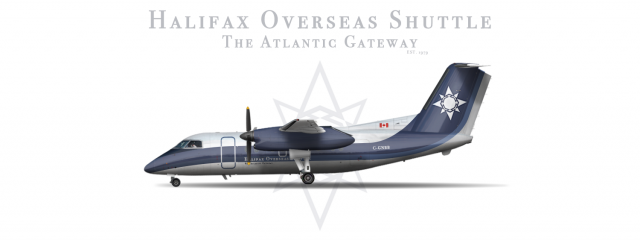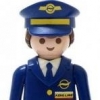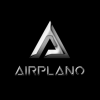
- Owner: Zac23 (View all images and albums)
- Uploaded: Jul 16 2021 11:14 PM
- Views: 2,044
- Album Halifax Overseas Shuttle
© Zac23 [You may NOT use, alter, sell, or distribute my work without EXPLICIT permission granted by Zac23 in writing] [Assistance: Bombstrich, Rigel, Arjay, makka, and AJB] [Template: Airplano21]

Halifax Overseas Shuttle
AIRFRAME - Bombardier Q100
REGISTRATION - C-GNBB
BASE - Montréal-Pierre Elliott Trudeau International Airport [YUL]
Halifax Overseas Shuttle's only goal wasn't mainline connections, but to connect the regional markets of Nova Scotia & Quebec. In an effort in the early 80s, the airlines operated a fleet of DHC-6s, DHC-7s, and Bombardier Q100s. With over 50 airframes of the three types, Halifax Overseas Shuttles operated to over 35 destinations year round that were not served by any other major Canadian airline. McKeen wanted to ensure that rural Canada got a connection to major airports at reasonable fares and frequencies. The company would go onto operate the Q100 through the 1980s, into the 1990s where the type was replaced by the Bombardier CRJ-100ER and CRJ-200LR. By 1984, Halifax Overseas Shuttle had expanded its route network into both St. John's and Toronto. The airline introduced new airframes into the fleet, including both the Boeing 757-200 and the Boeing 767-200.
In December of 1986, a Bombardier Q100 registered as C-GNBP crashed short of Halifax-Stanfield on an emergency landing. The flight operating as HO832, was flying from Halifax [YHZ] to Carlo [YCL] with a total of 36 passengers and 4 crew. Upon departure of Halifax, engine one experienced an uncontrolled engine fire causing mass damage to the wing. In a desperate attempt to make it back to Halifax, debris stuck the back aileron causing C-GNBP to begin an uncontrollable downspire. The aircraft broke apart at 4,900ft near Conrod Lake, killing all 40 souls onboard. This incident stood the only deadly crash in Halifax Overseas Shuttle's history at the time, and the first of two in the airline's history (HO113 crash near Goose Bay in 1989, killing 16 passengers and two crew).
Personal Notes:
why hello there ![]()
Cute!
Neat!
Very nice
Cute!
Neat!
Thanks!
The large dark blue line getting larger at the rear of the plane is a bit jarring; the way they curve up to the tail and leave a white space on the rudder makes the image seem forced rather than a natural compliment of the aircraft's shape; the large blue line also does not match up with the leading edge of the tail which draws your eyes away from the plane itself and toward the inconsistency; overall I don't think this plane wears the livery particularly well; though I think it would look better on an ATR
The large dark blue line getting larger at the rear of the plane is a bit jarring; the way they curve up to the tail and leave a white space on the rudder makes the image seem forced rather than a natural compliment of the aircraft's shape; the large blue line also does not match up with the leading edge of the tail which draws your eyes away from the plane itself and toward the inconsistency; overall I don't think this plane wears the livery particularly well; though I think it would look better on an ATR
Not every livery compliments a specific airframe well, it’s realism.
While the livery may look worse on the Q100 versus other airframes, the company was just adapting its standard livery onto the Q100.
Not every livery compliments a specific airframe well, it’s realism. While the livery may look worse on the Q100 versus other airframes, the company was just adapting its standard livery onto the Q100.
While this is true, this is why most liveries are basic, so they can appear across airframes in a consistent manner; and in the case of the Q100, it does not; at least not compared to the other aircraft you've posted thus far.
Adaptations have to be made for certain airframes, in which even basic liveries have to have modifications. This doesn’t back your claim on why basic liveries work best, as there will always be specific airframes that differentiate from mainline aircraft design that require such modifications. Complex or basic, certain designs will need to be modified to properly fit and display on the airframe that it is to be displayed on.While this is true, this is why most liveries are basic, so they can appear across airframes in a consistent manner; and in the case of the Q100, it does not; at least not compared to the other aircraft you've posted thus far.
Adaptations have to be made for certain airframes, in which even basic liveries have to have modifications. This doesn’t back your claim on why basic liveries work best, as there will always be specific airframes that differentiate from mainline aircraft design that require such modifications. Complex or basic, certain designs will need to be modified to properly fit and display on the airframe that it is to be displayed on.
I mean, fine, but the reason as to why I think basic liveries are best, is because they are basic. The more basic they are, the more consistent they are, it's not a claim; it's basic logic.
Adaptations have to be made for certain airframes, in which even basic liveries have to have modifications. This doesn’t back your claim on why basic liveries work best, as there will always be specific airframes that differentiate from mainline aircraft design that require such modifications. Complex or basic, certain designs will need to be modified to properly fit and display on the airframe that it is to be displayed on.
All I see is you dismissing some valid points because your pride got hurt. Would we rather just called your brand garbage and offer none of our thoughts? Because we can do that

 Sign In
Sign In Create Account
Create Account













